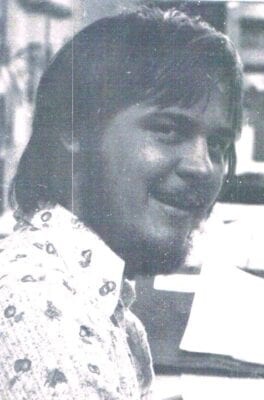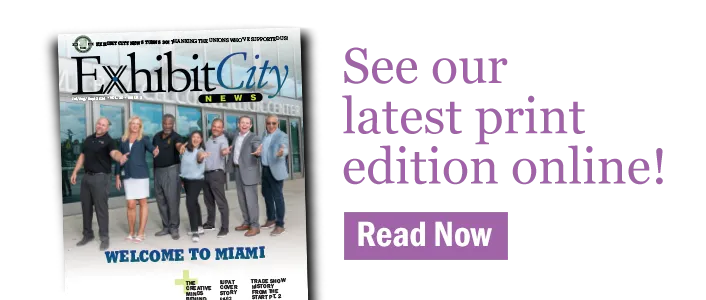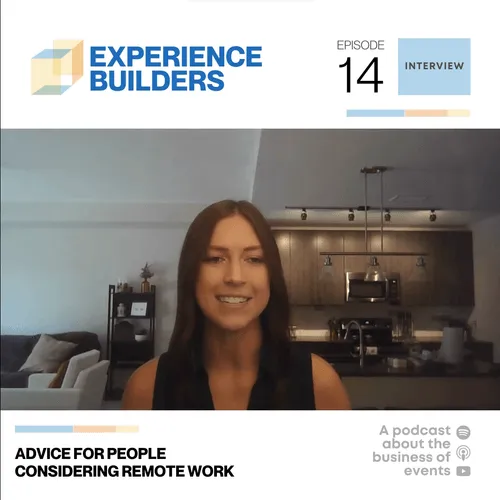Exhibit City News magazine will miss the musings of 50-year industry veteran Larry Kulchawik. We wish him the best in his retirement and in his search for new passions.
by Larry Kulchawik
 After 50 years in the tradeshow industry I’m hanging up my T square and stepping off the expo train. What a journey it has been! Unlike some in our industry who had family members introduce them to the thrills and joys of the traveling circus called tradeshow marketing, we each have fumbled into this secret occupation only to discover the addiction of its magic.
After 50 years in the tradeshow industry I’m hanging up my T square and stepping off the expo train. What a journey it has been! Unlike some in our industry who had family members introduce them to the thrills and joys of the traveling circus called tradeshow marketing, we each have fumbled into this secret occupation only to discover the addiction of its magic.
In 1971, with a degree in design and a minor in architecture, I found myself looking for work. A friend introduced me to Mertés Design, an exhibit design company in Chicago. The new McCormick Place was just rebuilt after the fire and happy days were here again for tradeshows in the U.S. For the next 10 years Chicago hosted the largest tradeshows in America. This was surely the place to be for exhibit design, fabrication and show site services. At that time other cities had excellent convention centers that were also popular (N.Y., Atlanta, Dallas, San Francisco, New Orleans and Atlantic City) but were limited in their space availability. Later, Orlando and Las Vegas offered space and cost alternatives to Chicago.
 As a designer and detailer, exhibits were designed by hand with magic markers and detailed with T squares and a triangular scale rule. Most all exhibits were made out of wood and painted in a spray booth. Graphics were silk screened directly to panels with minimal transparency photos. Hanging signs were rare and were made out of steel or wood. Most exhibit companies were in the heart of the city with shop fabrication on two or three floors in a tall warehouse. Crates were made to protect the exhibit and loaded on a truck with a “Johnny Bar.” Drayage weight was not an issue just yet, so some pretty heavy crates. Designers were expected to help load the truck then go back to holding a steady hand to finish a design drawing. Exhibit companies sent a carpenter to McCormick to assist installation with labor from a union pool of carpenters. I&D companies evolved a bit later, as well as furniture, floral, AV, and carpet companies. Lighting was mainly achieved with ball lights and stem lights with union electricians required to install and plug them in. Each show organizer hired a show contractor to manage freight and lay out the show floor with each space defined with pipe and drapes. Each space was identified with a 44” cardboard sign with company name and a booth number. Note that there were many different show contractors for show organizers to choose from in the ‘70s and ‘80s, that is until GES and Freeman bought them out and took over. Only in America!
As a designer and detailer, exhibits were designed by hand with magic markers and detailed with T squares and a triangular scale rule. Most all exhibits were made out of wood and painted in a spray booth. Graphics were silk screened directly to panels with minimal transparency photos. Hanging signs were rare and were made out of steel or wood. Most exhibit companies were in the heart of the city with shop fabrication on two or three floors in a tall warehouse. Crates were made to protect the exhibit and loaded on a truck with a “Johnny Bar.” Drayage weight was not an issue just yet, so some pretty heavy crates. Designers were expected to help load the truck then go back to holding a steady hand to finish a design drawing. Exhibit companies sent a carpenter to McCormick to assist installation with labor from a union pool of carpenters. I&D companies evolved a bit later, as well as furniture, floral, AV, and carpet companies. Lighting was mainly achieved with ball lights and stem lights with union electricians required to install and plug them in. Each show organizer hired a show contractor to manage freight and lay out the show floor with each space defined with pipe and drapes. Each space was identified with a 44” cardboard sign with company name and a booth number. Note that there were many different show contractors for show organizers to choose from in the ‘70s and ‘80s, that is until GES and Freeman bought them out and took over. Only in America!
After a financial crisis in the early ‘90s, many design and management methods within the industry changed to create new ways of thinking. Doing more with less was the motto. Silk screening diminished and was replaced with vinyl-cutting machines and inkjet printers for in-house graphic production. Most painting spray booths were eliminated and replaced with plastic laminates for color. Since drayage costs were based solely on weight, lightweight solutions were created to reduce this cost. Aluminum systems, portable exhibits, fabric exhibits, lighting and rental alternatives poured into the market to lighten the weight and decrease the cost of installation.
The industry saved money on drayage and handling but then introduced truss ceiling canopies to support AV screens and theatrical lighting to create environments that enhanced the exhibitor experience. Technology and computers stepped in strongly to complement the exhibit architecture as well as the fabrication methods.
Beginning in 2000, tradeshow marketing became more than designing creative exhibits. Exhibitors began expecting more than a cool looking exhibit. Exhibit suppliers offered design solutions that created a selling/telling environment and delivered an experience, using AV technology and theatrical lighting. The experience was not limited to the tradeshow floor. Pre-show, during the show, and post-show tactics were also a part of the overall design offering. These offering included off-site events and ways to measure a Return on Investment, Return on Objective and Return on Emotion. Tradeshow and event participation was now expensive. You better to be ready to help your clients to justify the marketing expense to their CFOs within their company. Add to this, the American discovery of the global marketplace to connect with global supply chains and expand their business. International tradeshow marketing unfolded with all U.S. exhibit suppliers becoming experts quickly to deliver this new need to assist their clients internationally. Boy, we sure had a good 40-year run!
2019 brought our industry to a screeching halt worldwide. For many, a sorrowful end to a good run. But for some, it’s a new beginning to build in a new future. Face-to-face marketing continues to be embraced as a powerful tool to grow sales, but tactics may be modified. Our methods may change but the power of emotion will not be extinguished. This is the real magic of tradeshows and events.
With the unfolding of the post-COVID chapter to our industry, and losing my pulse on tradeshow marketing today, I hang up my T square to ride off into the Colorado sunset to discover a new passion. Any new passion will be tough to replace.
To the many friends and associates I have met on my journey, as Bob Hope once said, “thanks for the memories.” I am so proud to have worked for three industry leading exhibit companies (Exhibitgroup, Derse and 3D Exhibits), and served on the boards of industry associations (OSPI, EDPA and IFES). I spent a lot of Sundays setting up an exhibit at McCormick, so the expo associations allowed me the opportunity to give back to my church (St. Expos) for future parishioners to enjoy the merits of the magical mystery tour we call the tradeshow industry.
It is important that we continue to give back through sharing knowledge and providing the educational tools to enhance the value of tradeshow marketing.
Also, much thanks must be given to our industry pipe organ, Exhibit City News and its publisher Don Svehla, for giving me a platform to share my thoughts.
Keep the train moving forward!
Larry Kulchawik is the head of Larry Kulchwawik Consulting and author of Trade Shows from One Country to the Next. For more info, visit www.larrykulchawik.com
This story originally appeared in the Mar./Apr. 2021 issue of Exhibit City News, p. 16. For original layout, visit https://issuu.com/exhibitcitynews/docs/ecn_mar-apr_2021



























